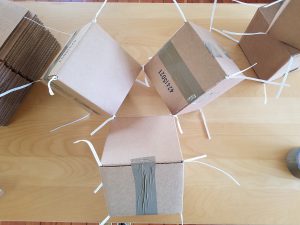Cuboxtahedron
Here’s a very pleasant first construction to make with your boxtets.
| Materials |
|---|
| 6 boxtets |
 |
To link two boxtets together at a vertex, first make sure that the two vertices are snug up against each other — don’t leave any space. Then twist the two (long ends) of the twist ties together tightly, roughly four half-twists. (I recommend always twisting clockwise when building, as it makes taking them apart easier; then you can always twist counterclockwise when disassembling.)
To make the cuboxtahedron, first connect three boxes in a triangle.
Then note that two edges of connected boxes make a sort of “V.” Turn that “V” into a triangle by adding a fourth box.
Do the same with the other two “V”s formed by the original triangle, and then bring all three of the new boxes up around top where their opposites sides will meet to form their own triangle, which you should fasten together.
And voilà, you have the cuboxtahedron!
Why do I call it that? The inner shape of this structure, consisting of one face from each boxtet and the triangular spaces among them, is a well-known semiregular polyhedron called a cuboctahedron. In our case, it’s missing more than half of its faces, but nevertheless creates a surprisingly rigid, symmetric, and pleasant structure for our simple construction. If you have more boxtets, you can continue attaching more of them at the vertices — see what happens when you do!





